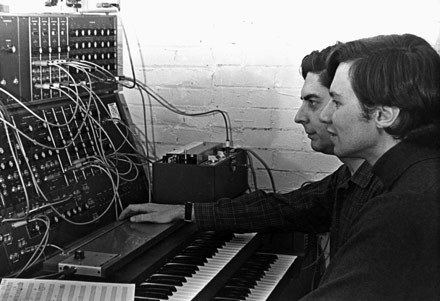Name Paul Beaver Role Musician | Albums Gandharva | |
 | ||
Died January 16, 1975, Los Angeles, California, United States Similar People Bernie Krause, John Curulewski, Michael Moorcock | ||
Music director The Final Programme | ||
Paul beaver bernard l krause the nonesuch guide to electronic music 1968 full album
Paul Beaver (1926 – January 16, 1975) was a jazz musician and a pioneer in popular electronic music, using the Moog synthesizer.
Contents
- Paul beaver bernard l krause the nonesuch guide to electronic music 1968 full album
- Paul beaver bernard l krause section 1 peace three
- Discography
- References

Beaver was the electronic half of a 1965 experimental free-form album for Dunhill Records with studio drummer Hal Blaine called "Psychedelic Percussion". (Blaine played drums on most of The Mamas and Papas albums, who also recorded for Dunhill Records, and many other pop-rock studio productions of the 1960s.) Beaver also played the Moog on "Star Collector", the final song on The Monkees' fourth album for Colgems Records, Pisces, Aquarius, Capricorn & Jones Ltd.; "Natural Harmony," "Goin' Back," and "Space Odyssey," on The Byrds' fifth album, "Notorious Byrd Brothers;" and was the Moog performer for The Zodiac : Cosmic Sounds project for Elektra Records in 1966.
Later in 1966, Beaver joined with fellow synthesist Bernie Krause to form Beaver & Krause, one of the first groups to record pop-commercial electronic music, which later became known as electronica. Their double album (2 LPs) The Nonesuch Guide to Electronic Music was a landmark work, introducing the public to the specific individual sounds that the Moog could make in great detail.
Paul was also a friend and associate of Sir George Martin, and he aided in the production of The Beatles' Magical Mystery Tour album, supplying the first-generation Hammond B3 organ which provided the strange sound effect at the end of "Blue Jay Way" (accomplished by switching the motorized 'tone wheel' off and on). Subsequently he played the Moog on "Because", "Here Comes the Sun" and "Maxwell's Silver Hammer" on the Abbey Road album. During this time he and musician-engineer Phil Davis built a custom polyphonic Moog modular synthesizer, based upon the Moog Apollo prototype, for Keith Emerson of Emerson, Lake, and Palmer that was one of the very first electronic instruments to have programmable preset sounds, controlled by an auxiliary 8-bit computer which used a TV monitor. Additionally Paul along with associates Phil Davis and Dan Wyman worked alongside composer Alexander Courage, composing and performing incidental ambient music ("The Cage" and others) and creating several memorable sound effects for the original Star Trek television series.
Beaver & Krause continued releasing electronic albums, first for Mercury Records' spin-off label, Limelight, with their album Ragnarok (1968), then three albums for Warner Bros. Records, In a Wild Sanctuary (1970), Gandharva (1971), and All Good Men (1972). Combining the Moog with acoustic instruments, these albums were effectively the beginning of the "New Age" musical movement.
The ending of the track, "Spaced" from the Wild Sanctuary album, which features two synthesizers simultaneously gliding up and down to merge into a final single chord, was later re-performed to become the musical soundtrack for the original THX logo used in movie theaters.
With Ruth White, Beaver established the Electronic Music Association in the 1970s. Beaver's health began to deteriorate in 1973, and he died in 1975 at the age of 49.
Paul beaver bernard l krause section 1 peace three
Discography
With Lalo Schifrin
